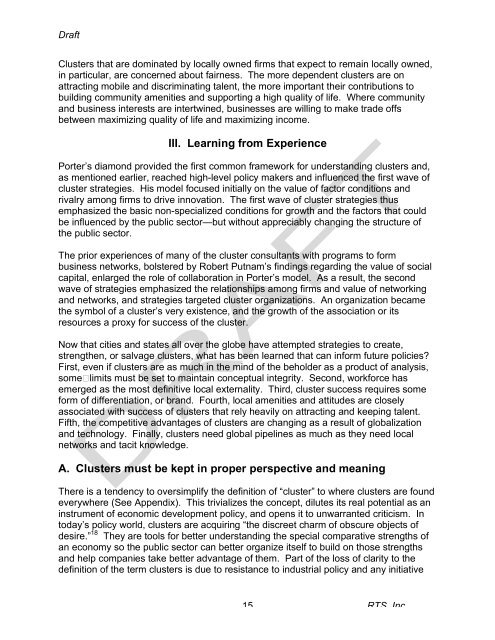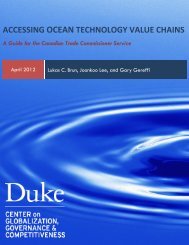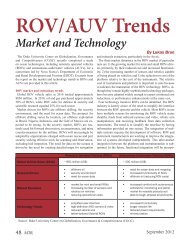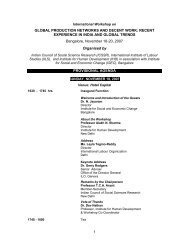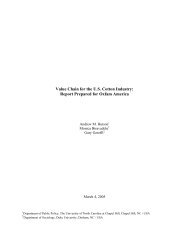Paper - Center on Globalization, Governance & Competitiveness
Paper - Center on Globalization, Governance & Competitiveness
Paper - Center on Globalization, Governance & Competitiveness
You also want an ePaper? Increase the reach of your titles
YUMPU automatically turns print PDFs into web optimized ePapers that Google loves.
Draft<br />
Clusters that are dominated by locally owned firms that expect to remain locally owned,<br />
in particular, are c<strong>on</strong>cerned about fairness. The more dependent clusters are <strong>on</strong><br />
attracting mobile and discriminating talent, the more important their c<strong>on</strong>tributi<strong>on</strong>s to<br />
building community amenities and supporting a high quality of life. Where community<br />
and business interests are intertwined, businesses are willing to make trade offs<br />
between maximizing quality of life and maximizing income.<br />
III. Learning from Experience<br />
Porter’s diam<strong>on</strong>d provided the first comm<strong>on</strong> framework for understanding clusters and,<br />
as menti<strong>on</strong>ed earlier, reached high-level policy makers and influenced the first wave of<br />
cluster strategies. His model focused initially <strong>on</strong> the value of factor c<strong>on</strong>diti<strong>on</strong>s and<br />
rivalry am<strong>on</strong>g firms to drive innovati<strong>on</strong>. The first wave of cluster strategies thus<br />
emphasized the basic n<strong>on</strong>-specialized c<strong>on</strong>diti<strong>on</strong>s for growth and the factors that could<br />
be influenced by the public sector—but without appreciably changing the structure of<br />
the public sector.<br />
The prior experiences of many of the cluster c<strong>on</strong>sultants with programs to form<br />
business networks, bolstered by Robert Putnam’s findings regarding the value of social<br />
capital, enlarged the role of collaborati<strong>on</strong> in Porter’s model. As a result, the sec<strong>on</strong>d<br />
wave of strategies emphasized the relati<strong>on</strong>ships am<strong>on</strong>g firms and value of networking<br />
and networks, and strategies targeted cluster organizati<strong>on</strong>s. An organizati<strong>on</strong> became<br />
the symbol of a cluster’s very existence, and the growth of the associati<strong>on</strong> or its<br />
resources a proxy for success of the cluster.<br />
Now that cities and states all over the globe have attempted strategies to create,<br />
strengthen, or salvage clusters, what has been learned that can inform future policies?<br />
First, even if clusters are as much in the mind of the beholder as a product of analysis,<br />
some limits must be set to maintain c<strong>on</strong>ceptual integrity. Sec<strong>on</strong>d, workforce has<br />
emerged as the most definitive local externality. Third, cluster success requires some<br />
form of differentiati<strong>on</strong>, or brand. Fourth, local amenities and attitudes are closely<br />
associated with success of clusters that rely heavily <strong>on</strong> attracting and keeping talent.<br />
Fifth, the competitive advantages of clusters are changing as a result of globalizati<strong>on</strong><br />
and technology. Finally, clusters need global pipelines as much as they need local<br />
networks and tacit knowledge.<br />
A. Clusters must be kept in proper perspective and meaning<br />
There is a tendency to oversimplify the definiti<strong>on</strong> of “cluster” to where clusters are found<br />
everywhere (See Appendix). This trivializes the c<strong>on</strong>cept, dilutes its real potential as an<br />
instrument of ec<strong>on</strong>omic development policy, and opens it to unwarranted criticism. In<br />
today’s policy world, clusters are acquiring “the discreet charm of obscure objects of<br />
desire.” 18 They are tools for better understanding the special comparative strengths of<br />
an ec<strong>on</strong>omy so the public sector can better organize itself to build <strong>on</strong> those strengths<br />
and help companies take better advantage of them. Part of the loss of clarity to the<br />
definiti<strong>on</strong> of the term clusters is due to resistance to industrial policy and any initiative<br />
15<br />
RTS, Inc.


